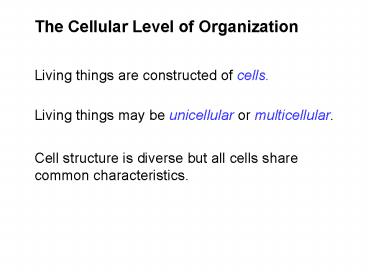The Cellular Level of Organization - PowerPoint PPT Presentation
1 / 32
Title:
The Cellular Level of Organization
Description:
The organelles of animal and plant cells are mostly similar to each other, but ... endoplasmic reticulum (ER) is a system of interconnecting tubes, channels within ... – PowerPoint PPT presentation
Number of Views:374
Avg rating:3.0/5.0
Title: The Cellular Level of Organization
1
The Cellular Level of Organization
Living things are constructed of cells.
Living things may be unicellular or multicellular.
Cell structure is diverse but all cells share
common characteristics.
2
The cell theory states
All organisms are composed of one or more cells.
Cells are the basic unit of structure and
function in organisms.
All cells come only from other cells.
3
Cells are small so they can exchange materials
with their surroundings.
Surface area relative to the volume decreases as
size of cell increases. - limits the size of
cells
4
Sizes of living things
5
Eukaryotic Cells
All cells are surrounded by a cell membrane, a
thin, flexible skin that holds in the rest of
the cell parts.
Eukaryotic cells have specialized organelles
inside the membrane that carry out functions for
the cell.
6
What the cell membrane looks like up close
7
The plasma membrane regulates what enters and
exits the cell. Some molecules can get through
the spaces in the membrane, some cant.
Inside the plasma membrane, cytoplasm is a
jelly-like substance that fills the cell. All of
the organelles are found within the cytoplasm.
The cytoplasm is always moving, and it carries
the materials cells need around the cell.
8
Animal and plant cells have organelles. Organelle
s perform special functions within the cell. The
organelles of animal and plant cells are mostly
similar to each other, but there are a few
important differences.
9
Animal cell anatomy
10
Plant cell anatomy
11
Structure of the Nucleus
The nucleus is sometimes called the control
center of a cell, because it is involved in such
processes as cell growth, metabolism and
reproduction.
A nuclear membrane surrounds the nucleus.
In most cells the nucleus contains the cells
DNA, which is the genetic material the cell uses
to build things that it needs.
12
The nucleus and the nuclear envelope
13
Another view of a nucleus
14
Ribosomes
Amino acids are hooked together to make proteins
within the cell by tiny organelles called
ribosomes.
Ribosomes can be found alone in the cytoplasm, in
groups, or attached to the endoplasmic reticulum.
15
Why are ribosomes so important?
- Its all about the proteins!
- Cells need to make proteins to do anything. Those
proteins might be used as enzymes or as support
for other cell functions. When you need to make
proteins, you look for ribosomes. Ribosomes are
the protein builders or the protein synthesizers
of the cell. They are like construction guys who
connect one amino acid at a time and build long
chains.
16
The endoplasmic reticulum
Many chemical reactions take place in a cell.
Proteins and lipids and other substances need to
be delivered to other parts of the cell.
The endoplasmic reticulum (ER) is a system of
interconnecting tubes, channels within the cell
substances can move from one part of a cell to
another through these channels.
There are two types of ER - rough ER is studded
with ribosomes (looks bumpy). Smooth ER lacks
ribosomes (looks smooth).
17
(No Transcript)
18
The Golgi Complex (sometimes called the Golgi
Apparatus, or the Golgi Bodies)
The Golgi Complex looks like Smooth ER. The
Golgi Complex receives protein from the ER, and
then packages, processes, and sends these
proteins elsewhere in the cell, or out of the
cell altogether.
19
Vesicles are bubble-like sacs that work like
packaging and transport units
20
Lysosomes and vacuoles
Lysosomes are little sacs of digestive enzymes
that break down old worn-out cell parts, waste
materials, and food molecules that are too large
for the cell to use. Sometimes they help protect
the cell by breaking down invading substances.
Lysosomes are mainly found in animal cells.
Sometimes the parts that are digested and broken
down can be recycled for use by the cell in
another way.
21
There are sacs called vacuoles inside the cell
that can store water, food, waste products or
other materials.
Most plant cells have at least one big one for
storing water. When its full it helps hold the
plant up. When its not full, the plant wilts
Animal cells can have vacuoles too, but they are
usually much smaller.
22
(No Transcript)
23
Energy-Related Organelles
The two energy-related organelles of eukaryotes
are chloroplasts and mitochondria.
Both organelles house energy in the form of ATP
24
Chloroplasts
A chloroplast is an organelle found in plant
cells. Chloroplasts are round, and green, and
contain chlorophyll, the substance plants use to
make food from sunlight.
25
(No Transcript)
26
Mitochondria
Mitochondria are found in plant and animal cells.
Mitochondria are large organelles where oxygen is
combined with glucose (sugar) to produce ATP, a
special energy-rich molecule that the cell can
use as a source of energy to do all the things it
needs to do.
Sometimes mitochondria are called the
powerhouse of the cell.
27
(No Transcript)
28
Prokaryotic Cells the oldest cells?
Prokaryotic cells include the single-celled
bacteria and archaea.
They are much simpler cells than the eukaryotic
cells. They do not have a nucleus, or many
organelles. What they DO have are
A cell membrane and a tough cell wall that helps
the cell keep its shape.
Ribosomes to make proteins
Long, twisty DNA molecules in the cytoplasm
29
Bacterial cells may have small accessory rings of
DNA. Some bacteria have a capsule or a slime
layer. Most bacteria have flagella, or whip-like
parts that help them move around.
Bacteria are a very diverse bunch.
30
A prokaryotic cell - bacteria
31
Another look at animal vs. plant cells
32
Thank you !
Thank you !
Thanks!
Yeah, thanks!































